A collection of recipes using the finest Maldivian tuna that is sustainably caught using the traditional methods of pole and line fishing.
Please visit www.maldivestuna.com for more information.
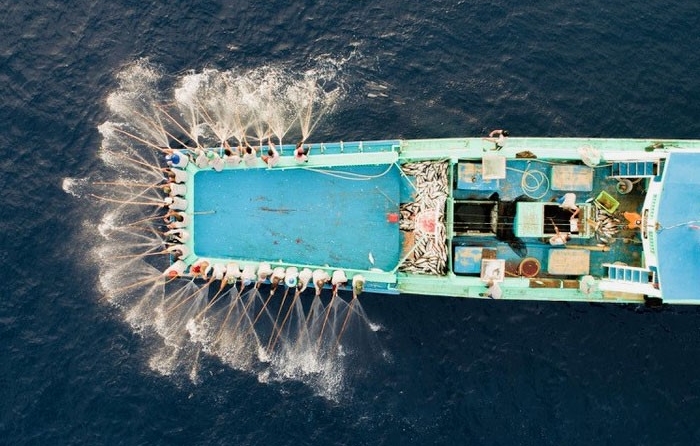
Maldivian tuna recipe: Mashuni (pronounced – Mas-huni)
Mashuni is an easy Maldivian recipe traditionally made for breakfast to be consumed together with baked flat bread named ‘roshi’ and tea. There are several variations of mashuni depending on the additional ingredients which often includes vegetables such as butternut or leaves from local plants such as moringa. Find a simple but delicious mashuni recipe below.
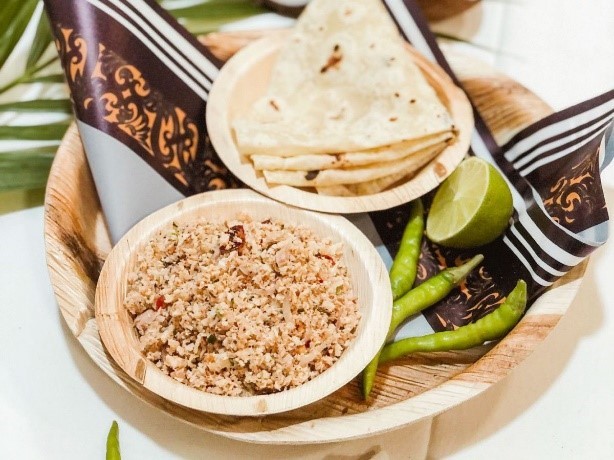
Ingredients:
- 1 cup smoked tuna or canned tuna chunks (diced or sliced)
- 1 cup coconut – scraped/grated
- 1 scotch bonnet (Chilli) – finely chopped
- ½ cup onion – finely sliced
- ½ cup lemon juice
- Salt to taste
Method:
- Squash the onions, and scotch bonnet with lemon juice and salt.
- Add the tuna and mix well.
- Mix in the coconut.
- Serve with Roshi or Farata (flat bread)
https://visitmaldives.com/en/experience/mas-huni-recipe
https://maldivescook.com/recipe/mashuni/
A Maldivian Tuna Stew recipe by Chef Ishag
Chef Ishag started his professional career at Full Moon Beach Resort in 1999 as commis, and currently works as an Executive Chef at Paradise Island Resort in the Maldives. With over 22 years of experience as a chef, several overseas training, culinary competitions (both local and overseas), he now holds 4 gold and 3 silver medals and numerous awards in the industry. Chef Ishaq is an active member and culinary judge of the Chef’s Guild of Maldives (CGM) and has served as a member of the Hotel Asia Culinary Challenge Judge committee. He has also been a judge of the Food and Hospitality Asia Maldives Culinary Challenge. Chef Ishag is a Worlds Association of Chefs Societies approved B License Judge, who is the 1st Maldivian to get the title since 2019.
https://www.villahotels.com/paradise-island/

Ingredients:
- 250g tuna steak cut into 1-inch cubes
- 30ml olive oil, divided
- Sea salt flakes
- 15g red onion, finely diced
- 30g bell pepper ribs and seeds removed, finely diced
- 30g bell pepper ribs and seeds removed, finely diced
- 15g capsicum chili pepper ribs and seeds removed, minced
- 5g large garlic cloves, finely chopped
- 60g greenhouse tomato diced
- 5g dry red chilies, seeded and thinly sliced
- 2g coriander seeds crushed
- 85g potato, peeled and cut into 1-inch cubes and blanched
- 200ml fish stock or broth
- 10g finely chopped fresh coriander
- 10ml fresh lime juice

Method:
- Heat 1 tablespoon of the oil in a large heavy bottomed flat pan.
- Season the tuna with salt and crushed coriander, sear it in batches over high heat until browned on at least two sides, about 2 minutes. Remove and keep on a plate.
- Add the remaining oil and the onion, peppers, garlic, chile flakes, and 1 teaspoon salt. Sautéover medium heat until the vegetables are very soft but not browned.
- Stir in the tomatoes and potatoes. Cover with the stock or water and bring to a boil. Turn the heat down to medium-low and simmer until the potatoes are tender and the broth has thickened, this process may take 8-10 minutes. Season with salt as
- Stir in half the lime juice, coriander, and tuna and cook another 2 minutes. Remove from the heat and let stand 2 minutes, until the tuna is heated through and just barely cooked.
- Serve the stew in bowls and garnish with the remaining coriander.
Recipe for Maldivian tuna cake “Boakibaa”

Aminath Nahee is a diplomat based at the Maldives High Commission in London as her first overseas posting. Missing the local taste of the food in her country, Nahee has been making various Maldivian short eats (delicious nibbles perfect for evening tea) hoping to rekindle the fond memories of her home. “Boakibaa is the comfort food that makes me nostalgic of my homeland. It is an easy and flavourful recipe for those who love just a little bit of spice” said Nahee.
Ingredients:
- 1 cup rice
- 2 cups water (for soaking the rice)
- 3 cans Maldivian tuna
- ½ cup grated coconut
- ½ tsp turmeric powder
- ½ tsp cumin powder
- 2 tsp grated ginger
- 2 tsp grated garlic
- 15-20 curry leaves
- 3 medium onions
- 1 & 1/2 limes
- 1 big red chili
- Salt to taste
- Vegetable oil (for the baking tray)

Method:
- Wash and drain the rice well. Then place it in a bowl along with the water and let it soak for at least 3-4 hours, overnight is better.
- Prepare a tray by rubbing a little bit of oil on the bottom and the sides.
- Preheat the oven to 180 degrees Celsius.
- Drain the soaking water, and then mix the soaked rice with grated coconut and grind. The texture should not be too smooth but not too coarse.
- In a bowl, mix together the sliced onions, curry leaves, chili, ginger, garlic, cumin, turmeric, salt along with the lime juice. Squeeze the mixture between your fingers to release their juices.
- Then add Maldivian tuna and mix well again.
- Then add the ground rice and coconut mixture. If the mixture is too dry add a little bit of water. The consistency of the mixture should be wet but not too runny.
- Mix everything together and it is ready for baking.
- Place the tray (middle rack) in the preheated oven and bake until the top gets brown (roughly 35-40 mins). A toothpick inserted in the middle should come out clean.
Quick seared Maldivian tuna with jalapeno dressing and wakame salad by Chef Ahmed Mazim
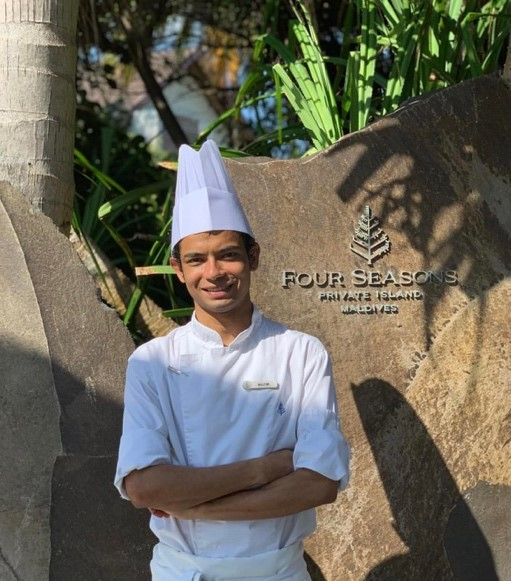
With 5 years of experience in the industry, chef Ahmed Mazim shuffling between Four Seasons Landaa Giraavaru and Four Seasons Private Island Voavah says “Being a chef is tough but I enjoy the ride”. Chef Mazim started his career with the Four Seasons apprenticeship program in the year 2015. He is currently working as a Chef De Partie. Although he is familiar with all the international cuisines, his specialties are Chinese cuisine and Japanese cuisine/ Teppanyaki. In the year 2017 he got the opportunity to go to Four Seasons Beijing and worked in Cai Yi Xuan the Two Michelin starred restaurant from where he dispersed his skills to Landaa. Chef Mazim participated and achieved great success in live cooking culinary competitions nationally and internationally. One of his greatest achievements includes the Bronze medal in the Chinese Cuisine World Championship in the year 2019 and Young chef award in the year 2016 by Hotel Asia Culinary Challenge.
https://www.fourseasons.com/maldivesvoavah/
https://www.fourseasons.com/maldiveslg/
https://m.facebook.com/merine
www.instagram.com/ah.mazim
Ingredients:
Jalapeno dressing: Wakame salad: Oba oil:
300g jalapeno - 50g Soaked wakame - 200g oba leaves
50g garlic - 8g thinly sliced cabbage - 50ml Grape seed oil
370ml grape seed oil - 5g thinly sliced onion
350ml rice vinegar - 5g thinly julienne carrot
15g Salt - 6ml soy sauce
- 2ml yuzu juice
- 2ml sesame oil
- Fresh Maldives tuna
- Salt for seasoning
Method:
- Deseed jalapenos and blend them together with garlic, grapeseed oil, rice vinegar, and salt.
- Mix together the Soaked wakame, thinly sliced cabbage, onion, carrot, soy sauce, yuzu juice and sesame oil to prepare Wakame salad.
- Fry oba leaves in grape seed oil and let it cool down a bit and blend it. Strain using a cheesecloth.
- Season the tuna with salt and sear it in a very hot pan, thinly slice the tuna and serve with jalapeno dressing and wakame salad. Drizzle oba oil on top.
Kopee Leaf and Maldivian Tuna Mashuni by Chef Ahmed Faisal
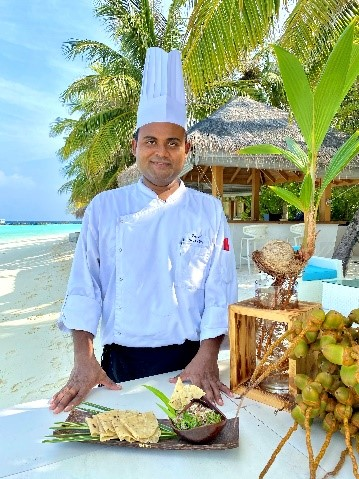
Chef Ahmed Faisal is a certified Culinary Art Chef with 13 years of extensive professional experience in international, multi cuisine operations. He started his career as an Assistant Cook in 2006, and since then has been continuously feeding his passion for cooking and improving his qualifications, all whilst maintaining a steady career in luxury resorts of the Maldives. He now works as a Sous Chef in Kurumba Maldives joining the team in early 2020. Chef Faisal is also certified in pastry, bakery and commercial cookery and had his outstanding skills recognized when he was awarded bronze, silver, and gold medals at the Hotel Asia Maldives Culinary Challenge. He hopes to share his passion and his knowledge to inspire the younger generations to hone their skills in the kitchen. Kurumba offers private and group cooking classes upon request, where you have the opportunity to learn about Maldivian cuisines, its key ingredients along with a tour of the resort’s very own herb garden.

Ingredients:
- ½ a small onion
- ½ a small red or green chili pod
- juice of half a lime
- 1 large Kopee leaf
- 3 curry leaves
- a pinch of salt
- a pinch of ground black pepper
- 50g Maldivian smoked tuna
- 3 tablespoons of coconut shavings
- ½ teaspoon of fish paste - Rihaakuru
- fried curry leaves
- fried chili
- fresh pandan leaves
- crispy roshi (flat bread)
- coconut chips
Method:
- Cut the onion in half and slice it. Slice the chili pod and add it to the onion.
- Sprinkle sliced chili and onion with lime juice.
- Lay the kopee leaf on a chopping board, remove the stem, roll up the leaf tightly and slice it finely. Keep it aside.
- Roll up curry leaves, slice them and add them to the chili and onion.
- Add salt and pepper powder.
- Mix the ingredients roughly until the juice comes out.
- Add pre-sliced smoked tuna.
- Top up with Rihaakuru, coconut shaving and mix the ingredients.
- It is time to add kopee leaf, mix it thoroughly and place the salad in a bowl.
- Garnish the salad with fried curry leaves, fried chili, pandan leaves, crispy roshi and coconut shavings.
Hand carved Maldives Tuna dish by Chef Mohamed Adil
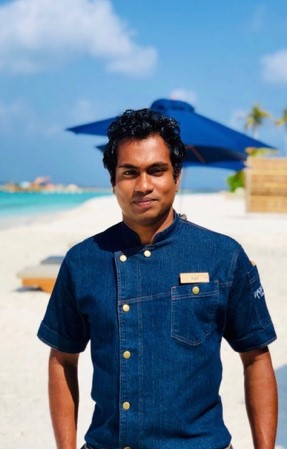
Mohamed Adil, Chef De Cuisine at Dhigali Maldives an award-winning Maldivian chef who has become one of the most accomplished in the country. Hands on and passion driven chef Adil with over 9 years of culinary experience has won national and international awards and medals. Chef Adil enjoys using Maldivian tuna and has shared one of his favorite recipes with us. Chef Adil wants to be recognized around the world as a chef that represents the essence of the Maldives: “I aspire to be known as a chef who has magic to turn ingredients into gold through my imagination and art of cooking. I want to do what I love to do. The years do not matter. I want to do what I love to do. I love my jacket and would like to see more accolades on them”.
https://instagram.com/mohmd.adil?igshid=8om6huk1iuj2

Ingredients:
Cured tuna
120g Maldivian yellowfin tuna
2g Roasted and crushed coriander seeds.
2g Roasted and crushed cumin seeds.
10g Salt
10g Sugar
Mango ceviche
80g Maldivian mango (if not Thai mango or any preferred)
30g Red onion
1g Maldivian chili habanero
60g Lime
To taste Salt
To taste Black pepper
1g Coriander fresh
Method:
- For the cured tuna mix in a bowl the salt, cumin, coriander seeds and sugar. cover the tuna fillet with the mixer. Leave it in the fridge for 1 hr. Once done remove the mixture using the back of a knife or scrapper. Take nice 5 thick slices and arrange on the plate.
- For the elderflower gel, in a small pan add lemon juice, muddled lemongrass, kaffir lime leaf, black pepper and elder flower syrup. Cook at a very low temperature till it becomes a nice syrup consistency and strain it.
- For the mango ceviche, In a mixing bowl add finely sliced onion, chopped chili, chopped coriander, and lime juice. Macerate them properly and season with salt and pepper. Toss in mango dices and keep them in the fridge.
- Take the thin slices of radish and marinate them using the elder flower gel, arrange them forming a circle besides tuna. Arrange the mango dices length wise on the left side of tuna. using a squeeze bottle do some dots of the gel in between the mango dices.
- Garnish with micro herbs, chili garnish and edible flowers.
Marinated Tuna with Coconut and Lime juice by Chef Faiz Idrees
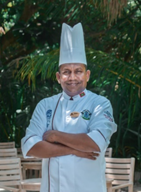
This newsletter’s recipe is the courtesy of Chef Faiz Idrees, Executive Chef counting his 6th year at Coco Palm Dhuni Kolhu. Previously, Chef Idrees was an Executive Chef at Club Med for 26 years. In the field of culinary arts, he had the opportunity to train professionally in both France and in Malaysia which allowed him to pick up several different techniques and tricks in the preparation of his dishes for a variety of cuisines. He is also a proud and active member of the Chefs Guild of Maldives, a non-profit organisation dedicated solely to the advancement of the culinary art of the Maldives.
https://cococollection.com/en/palm_dk
https://www.worldchefs.org/Country/Maldives

Ingredients:
- 75 pounds tuna (Maldivian Fresh Tuna)
- 8 limes juice
- 1 large onion (2.8 ounces)
- 1 bell pepper (green)
- 1 tomato (1.75 ounces)
- 1/2 cucumber (3.5 ounces)
- 1 glass of coconut milk
- Salt (to taste)
- Black pepper (to taste)
Method:
- Dice the fish into 1/2-inch cubes, rinse with fresh water, drain and place in a large salad bowl. Some recipes call for a little salt in the water, but this is optional and a matter of taste.
- Squeeze the limes and pour the juice over the fish. Mix well and chill for 15 to 20 minutes in the refrigerator.
- Cut onion and green pepper into thin slices, cut tomato into small cubes, remove seeds from cucumber and cut into thin half-moons.
- Drain some of the lime juice, add the vegetables and season with salt and pepper.
- Five minutes before serving, add the coconut milk.
- Present on a bed of lettuce, on individual plates, or, even better, in a coconut shell. Serve chilled.
Tuna Tartare by Chef Adam Zahir
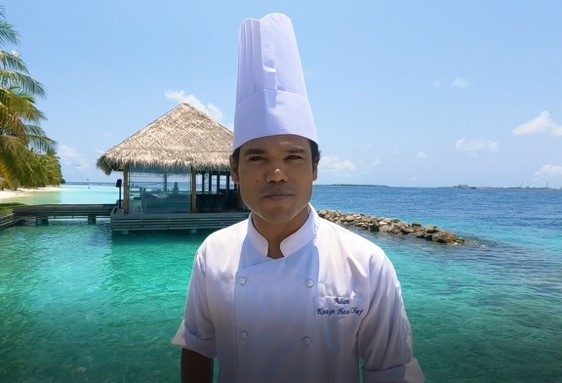
A native of Sh. Milandhoo, Adam Zahir (Adam) found his calling to cuisine while he was studying in Sh. Milandhoo School. Even though he was a shy kid since childhood, he always loved to help his mom when she cooks for the family. In 2007, at the age of 17, Adam got the opportunity to work in Chaya Dhonveli Beach Resort as a commis in the Staff Canteen. Since then, Adam never looked back. After working in Chaya Dhonveli & Giraavaru Island Resort, Adam moved to Taj Exotica Resort & Spa as a Demi Chef in Staff Canteen in 2009. In 2010, at the age of 20, Adam joined Boduhithi Island Resort and Spa as a Head Chef in the Staff Canteen. Being there at Boduhithi for 3 years, Adam has mastered his cooking skills and joined Holiday Inn Resort Kandooma Maldives in 2013 and later on worked in Kihaadhuffaru Island Resort as a Head Chef in the Staff Canteen. In 2019, he joined Kurumba Maldives as the Head Chef for team member restaurant Kaage, and soon became an indispensable asset to the restaurant, bringing his exquisite palate and creativity to everything he touched. Adam is very passionate about his job and has a great knowledge of Local, Indian & western Cuisines. It takes a lot of patience, dedication, and hard work to reach the top of one’s profession and a lot of hard work to keep the position. Adam Zahir (Adam) is a true example of that.
https://www.youtube.com/watch?v=HkkX0xS7D9Y

Ingredients:
- 110g Maldivian Yellowfin tuna
- 1tsp of freshly grated
- 1tsp coconut puree
- ¼ tsp chopped chives
- 2 tsp chopped onion
- ½ tsp fried onion
- 2tsp lemon juice
- ¼ tsp chopped lemongrass
- ¼ tsp peeled and chopped ginger
- ½ tspRihaakuru (smoked fish paste)
- 3tsp olive oil
- Salt
- 3pc fried curry leaves
- Pink salt
- 2 sprigs Coriander leaves
Method:
- Remove and discard any dark parts from the bloodline of the yellowfin tuna. Finely dice and place in a large bowl.
- Add the onion, lemon juice, olive oil, grated coconut, salt to the diced tuna and mix gently.
- Dress on the plate, dot with coconut puree and a few dots of Rihaakuru around the tuna.
- Garnish with coriander sprigs, fried curry leaves and fried onion.
- Sub prep for the coconut puree: in a sauce pan, boil the coconut puree with lemongrass and ginger, reduce into half and then cool down and strain
Seared yellowfin tuna with coconut curry sauce by Chef Sobah
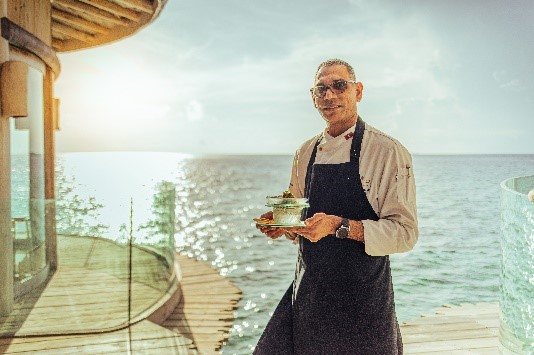
Abdulla Sobah is the Chef de Cuisine at Soneva Fushi and one of the most talented chefs in the Maldives with numerous culinary awards and distinctions such as the ‘Best Chef in the Maldives’ in the annual Food & Hospitality Asia Maldives (FHAM) – International Culinary Challenge & Exhibition. Chef Sobah first became interested in food and cooking through his family that maintained traditional flavors whilst cooking local dishes. He later went on to study at the Faculty of Hospitality and work with some of the most famous chefs around the world upon joining the Soneva team. Although he is a specialist in preparing many different cuisines such as Sri Lankan, Vietnamese, and Thai, he is famed for being a champion of Maldivian cuisine. He strives to produce clean and flavorful dishes by using natural and fresh ingredients that are mostly grown on the island. He advises all ambitious chefs to never stop learning and to be innovative in their own culinary journey.
https://www.youtube.com/watch?v=x7rBpznrNMg

Ingredients:
- Maldivian Yellowfin tuna – 180g
- Cajun spicy – 2g
- Fried garlic – 25g
- Fried onion – 25g
- Curry powder – 2g
- Olive oil - 10 ml
- Coconut curry sauce - 150 ml
- Crispy rice – 5g
- Dry brown coconut – 5g
- Lemon - 1
- Dill – for garnish
- Butterfly pea flower – for garnish
- Salt to taste
- Black pepper to taste
Method:
- Marinate the tuna with lemon juice, Cajun spicy, salt and pepper.
- Heat the oil in sauté pans over medium high heat. Add tuna to the pan and sear on all the sides until the Cajun powder are evenly toasted - about 25-30 second per side (interior of tuna will be rare. Do not overcook) remove from pan; let it stand for 4 minutes.
- Cut the tuna into small pieces.
- Place the tuna on a plate and around it, add coconut curry sauce.
- Garnish with some fried onion, fried garlic, dry brown coconut, and crispy rice.
- Add dill herbs and butterfly pea flower.
- For the coconut curry sauce take a saucepan and add all the ingredients. Heat the pan on slow fire and cook ingredients gently until sauce thickens.
‘Kulhimas’ (Spicy tuna) recipe by Taste of the Maldives in London

‘Taste of Maldives’, a home delivery service of Maldivian cuisine, was developed by Maldives-born Mr. Maish Ahmed, living in London with his family. The lack of Maldivian cuisine in London drove Maish to start his own Maldivian food delivery service by creating an Instagram account to reach Maldivians across the UK. Beginning with just a few humble items on the menu, today, Maish and his family have more than fifteen dishes available to order. While his mother cooks most of the food, his little sister acts as the photographer. Maish and his family are pleasantly surprised and encouraged by the support they have received throughout. ‘The growth is amazing’, stated Maish. To try some Maldivian cuisine, click the following Instagram link taste_of _maldives.uk or email them at This email address is being protected from spambots. You need JavaScript enabled to view it.

Ingredients:
- 1 can Maldivian Tuna
- 1 medium onion
- 2 cloves of garlic
- Small piece of Ginger
- 1 curry leaf
- 4-inch piece of Pandan leaf
- 2 green chilies
- 3 tbsp salt chili powder
- 1 tsp cumin powder
- 2 tbsp tomato paste
- olive oil
- ½ cup coconut milk
- black pepper
Method:
- Finely chop onion, garlic, ginger, and green chilies.
- add 2 tbsp olive oil to a hot pan.
- Add pandan and curry leaves to the pan along with finely chopped onions, garlic, ginger green chilies and sauté.
- Add salt chili powder and cumin powder to the onion mixture and stir.
- Add tomato paste and stir.
- Add tuna and adjust salt and pepper to liking.
- After mixing everything thoroughly add coconut milk into the pan and mix.
- Keep under low flame and cover for 5 minutes.
- Ready to serve with some roshi (flat bread) or rice.
Maldivian Tuna Seared on a hot block of salt by Chef Ravi

Chef Ravi Poojary is the Head Chef of Soneva Fushi’s International and South Asian restaurant ‘Down to Earth’ where he aims to recreate the intimacy of sharing food through his dishes. Chef Ravi stated that “I always cook from the heart. When I welcome guests to my restaurant, I am welcoming them to my home”. He initially started cooking to support his family and gradually became inspired by the guests he served and the chefs he worked with. Cooking lessons with Chef Ravi in Soneva is one of the bests ways for guests to learn about Indian food and unique flavours.

Ingredients:
- 160g Maldivian Tuna
- 20g fresh rosemary
- 20g Honey
- 20g Soya sauce
- 20g Lime slice
- 10g Lime juice
- 10ml Pepper
- 10ml Olive oil
- 100g Mixed vegetables
- Steamed rice
Method:
- Marinate the tuna with pepper only and keep at a side.
- Steam the vegetables and keep at a side.
- Take a small saucepan and add honey, soya sauce, lime slice, lime juice and then cook together and keep at a side.
- Take the salt board and make it very hot in oven at 200 degrees for 15minutes. Take it out and add some olive oil. Then put on the tuna slices and seared the tuna each side if you cut square loin 4 side also cook very well. And then add the lime slice on top the tuna and pour the honey soya which is you precook and keeping on side.
- And serve hot with steamed rice and steamed vegetables on side.
Blooming Tuna by Chef Mickael Viljanen

Chef Mickael Viljanen is one of Soneva’s Visiting Chefs for the month of April this year. He is the Chef Patron and co-owner of the restaurant Chapter One by Mickael Viljanen in Dublin, Ireland. He previously worked as the executive chef of The Greenhouse restaurant in Dublin since 2012, where he held two Michelin stars. Chef Mickael stated that “I always loved cooking; I knew when I finished school, I had no interest in going to study anything else.” He started cooking part-time at the age of 14 and gradually climbed the ladder to become one of the best chefs in Ireland. His awards and accolades in the industry include titles such as “Chef of the Year” and “Restaurant of the Year”.

Ingredients and Method:
Tuna Dish:
- 200g tuna sliced
- Sea Salt 6g
- lime juice 30g
- Palm sugar 15g
Marinate the tuna with salt, palm sugar and lime juice for 5 minutes
Bouillon:
- 500ml elderflower cordial
- 750g rice wine vinegar
- 600g green apple puree
- 250g lime syrup
- 20g jalapeno
- 3 chopped green apples
Blitz all together in blender and pass through a fine sieve
Herb oil:
- 500ml corn oil
- 200g dill
Blitz together to a green oil and pass-through a sieve
Frozen Horseradish:
- 50g horseradish
- 150g milk
- 850g buttermilk
- 30g corn flour
Boil milk and horseradish with corn flour, cool to 50°C, add buttermilk and freeze.
Place in to Pacojet to freeze overnight, spin before serving.
To Garnish:
Flowers and herbs from the garden or as preferred
My Tuna Passion by Chef Giovanni De Ambrosis
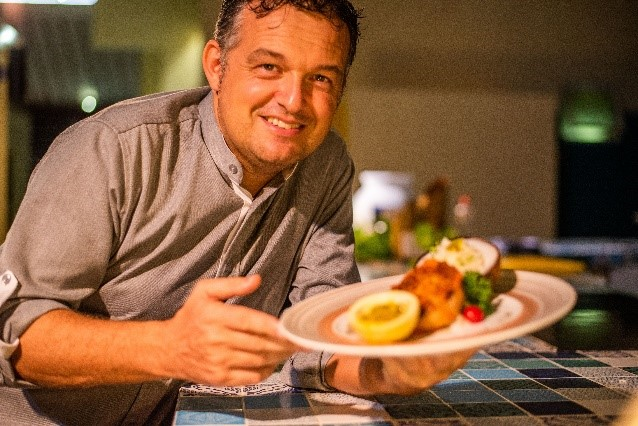
Award-winning, progressive culinary professional with over 30 years of experience in world-class resorts, hotels and restaurants. Chef Giovanni De Ambrosis exemplifies professionalism and has the ability to drive clients’ satisfaction and retention through the creation of quality food, while fostering a friendly and pleasant dining experience. With his extensive knowledge, he has strong business administrative insight, along with recruiting, training and interpersonal skills. Chef Giovanni De Ambrosis is a calm, pleasant and hardworking individual. He has proven his experience in international operations and has a history of providing support and leadership to kitchen staff. His ability to create an enthusiastic productive working environment, and maintain a reputation of quality, service and dedication, has brought him to where he is today, The Ambassador of Italian Taste.

Ingredients:
- Yellow Fin Tuna 150g
- Salt & Pepper 5g
- Coconut Oil 10ml
- Green Local Maldivian Chilli 5g
- Papaya Ripe 15g
- Coconut Milk 100ml
- Rice (any) 40g
- Passion Fruit 1pc
Method:
- Marinate tuna darne for 30 min in a mashed papaya, green chilli, salt & pepper.
- Combine rice, water & coconut milk and cook for 18 min.
- Add a generous swirl of coconut oil on a hot pan and sear the marinated tuna within 2 min per side, pot should be very hot, crusted in both side of fillet.
- Served over a bed of coconut rice with fresh passion fruit dressing.
Seared tuna with citrus, pistachio crust by Chef Maha Naseer
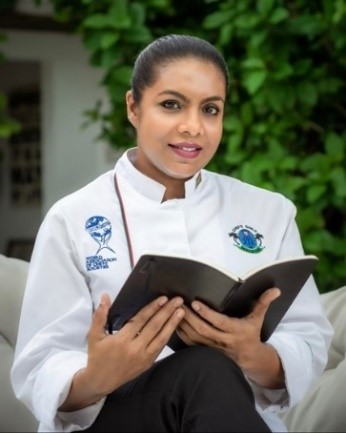
Chef Maha Naseer is a Pastry Chef, Entrepreneur, Instructor, Baker, Decorator, Freelance F & B Consultant and Pastry Designer, Resort pastry Instructor, Seasonal Guest Chef, World Chefs approved rookie Judge in pastry. Chef Maha is also the Secretary General of Chefs Guild of Maldives. “With earliest baking inspirations stemming from patisserie and culinary pages on the magazines, I developed an instantaneous passion for baking, at the age of eight. With the pure and beautiful curiosity of a child, I began experimenting with recipes from those magazines. The yearning was heightened from the immediate support and compliments received for my aptitude and natural talent as a baker. With the sole purpose of delivering my unbridled potential and creations to as many as possible, the dream commenced”.

Ingredients:
- 6 baby potatoes
- 100g unsalted, shelled pistachio nuts
- Zest from 1 lemon
- 250g tuna fillet
- A splash of olive oil
- 2 tablespoons Dijon mustard
- Knob of butter
- 1 tablespoon parsley
- 2 cloves of garlic, crushed
- Maldon sea salt and black pepper
- Optional: Green salad and baby radish.
Method:
- Pre-heat the oven to 200°c.
- Give the baby potatoes a wash and pop them into a pot of salted water, bring it to the boil and leave them to cook. Once they are cooked through, set them aside and leave to cool.
- Put the pistachio nuts and lemon zest into a food processor and grind them up until you are left with a beautiful, textured, green grain. Pour the pistachio grain onto a baking dish and set aside.
- Transfer your tuna fillet onto a clean chopping board. Using a very sharp knife, cut the tuna into two oblong fillets. The thickness should be the same size as when you make a circle by touching your thumb and index finger together.
- Rub each fillet generously with olive oil.
- Heat a big pan. When the temperature is very hot, drop the tuna fillets into the pan and sear each side for 1 minute. Take the fillets off the heat, lather them with a tablespoon of mustard and roll them in the pistachio grain until they are covered with a thick layer.
- Put the tuna into the oven for 3 minutes.
- Melt a knob of butter in a pan, drop in the parsley as well as a teaspoon of garlic. When the parsley butter is nice and hot, drop in the potatoes and swirl them around in the butter until they are heated through and coated.
- To plate, cut the potatoes in half and lay them flat side down on the plate Thinly slice your tuna fillet and place neatly over the bed of potatoes.
- Serve with a simple green salad with some baby radish.
Maldivian Kandu Mas Tuna Recipe by Chef Faiz Idrees:
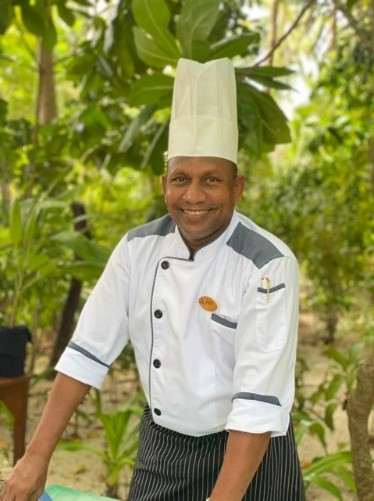
Faiz Idrees is the executive chef at Coco Palm Dhuni Kolhu’s and has been with the resort since 2014. Previously, Chef Idrees was an Executive Chef at Club Med for 26 years. He had spent time training and working in several different countries such as Japan, Australia, New Caledonia, Mauritius, Indonesia, Malaysia and Thailand. Chef Faiz leads a team of 52 staff in the resort, catering to the tastes of more than 200 guests every day.
https://cococollection.com/en/palm_dk
Ingredients:
- 300grams Maldivian Tuna
- 1-2 limes juice
- 50ml Fresh coconut milk
- 1 onion
- 1 bell pepper
- 1 tomato
- 1/2 cucumber
- salt & pepper (to seasoning)
Method:
- Tuna cut into ½ inch cubes
- Onion, bell pepper, tomato and cucumber cut into fine brunoise
- Fish and all the vegetables place in mixing bowl.
- Squeeze the limes and pour the juice over the fish
- Add the coconut milk
- Seasoning with salt & pepper
- Place the mixture in the chiller for 15 – 20 minutes
Spicy Maldivian Tuna recipe by Chef Joao Costa
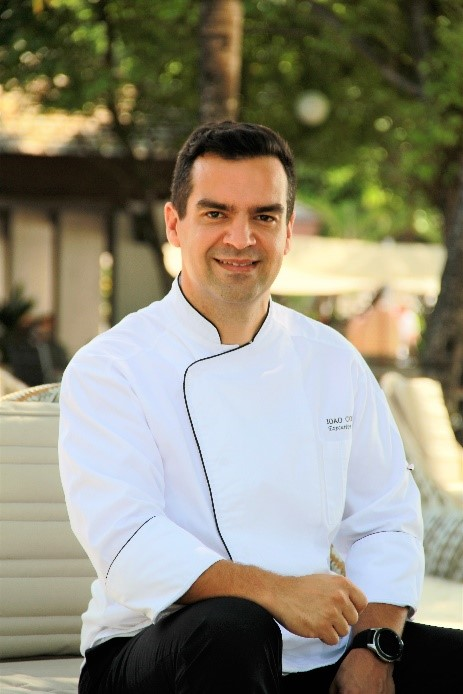
Bring a piece of the island at home with this Maldivian Tuna dish prepared by Velassaru Executive Chef Joao Costa. Originally from Portugal, Chef Costa learned the heritage of Mediterranean cuisine from his grandmother and family. Passionate and curious about kitchen and cooking techniques, Chef Costa's approach to cooking is to present a classic cuisine on a modern and innovated way. He graduated from hospitality school in Algarve, and he began his career in South of Portugal. He specialises in Mediterranean cuisine, western cuisine, fine dining, Arabic, European, and banquets. He is known for his kitchen and cooking style for mixing flavours and textures using seasonal and local ingredients combined with creative culinary techniques from around the world.

Ingredients:
- 200g yellow fin tuna loin
- 250g green peas
- 125g green asparagus
- 50g cherry tomatoes
- 75g butternut squash pumpkin (cubed)
- 3 shaves dried coconut meat
- 10g Cajun spicy powder
- 10g chili powder
- 10g cumin powder
- 10ml coconut oil
- 10ml olive oil
- 25g unsalted butter
- 15g chopped butter
- Salt and black pepper to taste
Method:
- Mix all the powder ingredients together, season with salt and black pepper to taste. Then place the tuna loin in the mixture and set aside.
- To prepare the green peas purée, bring a pan of water, seasoned with salt, to boil and cook the green peas. Transfer to a blender and purée with the butter. Blend until creamy.
- Prepare the butternut squash pumpkin and green asparagus for blanching. Cut the pumpkin in even cubes (1 1/2 inch thick). Cook until al dente in hot water then plunge into iced water and drain.
- To sear the Tuna loin, add olive oil to the hot pan over medium-high heat; sear loin evenly on all sides, until golden colour.
- When ready to serve, sauté all the vegetables and chopped garlic in coconut oil in a small pan.
- To plate: spread green peas purée on the plate, place the tuna and vegetables. Garnish with coconut shaves, micro greens, and edible flowers.
Tuna Tataki by Chef Sara Ali Naseer
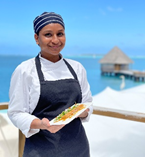
Born within the thousand isles of Maldives, Ms. Sara Ali Naseer is a young and capable chef working in Conrad Maldives Rangali Island. As one of the few women Chefs working in the tourism industry, Sara has always been talented at making different varieties of delicious dishes. Cooking these dishes became something more than a simple interest when Sara went on to study culinary arts in a programme accredited by Le Cordon Blue at Sunway University in Malaysia.
https://www.youtube.com/watch?v=F1y9eOYR9Vk

Ingredients:
- 1 Tuna Loin
- 5 Dried Chillies
- 1 Scotch Bonnet
- 1 Cup Coconut Milk
- 1 Onion (fine diced)
- 5 Tablespoons Rihaakuru
- 1 Cup Desiccated Coconut
- 2 Tablespoons Olive Oil
- 3 Tablespoons Mirin Vinegar
- ¼ Cup Lemon Juice
- 5-6 Curry Leaves
- 5 Pandan Leaves
- Salt & Pepper
- 1 Kopee Leaf (Perennial Kale)
- 10 Jasmine Flowers
- 3 Cups Coconut Water
- 1 Tablespoon Coconut Flesh
Method:
- In a mixing bowl, add onion, scotch bonnet, dried chillies, curry leaves, salt & pepper and lemon juice.
- Mix it well and add rihaakuru, coconut cream, mirin vinegar.
- Mix the marinade and squash the ingredients well.
- Pour the marinade on the Tuna Loin and let rest for 45 minutes.
- Pre-heat the pan and drizzle some oil onto the pan. Seal all the sides of the Tuna Loin and put it back in the marinade.
- Toast the desiccated coconut with pandan leaves until it is golden brown.
- Chiffonade the Kopee leaf and mix with jasmine infused coconut water and add lemon juice.
- Sprinkle the cooked desiccated coconut on all sides of the Tuna Loin and then slice the Tuna Loin.
- Drizzle on some marinade on the Tuna Loin pieces and serve with the prepared salad.
Beetroot ravioli stuffed with yellowfin tuna, mango sauce, black olive powder
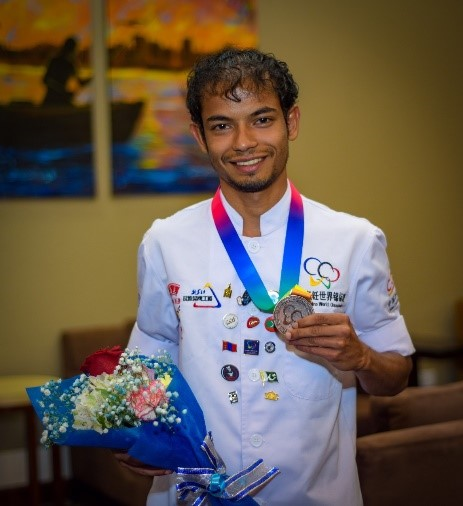
With 5 years of experience in the industry, Chef Ahmed Mazim shuffles between Four Seasons Landaa Giraavaru and the Four Seasons Private Island Voavah. Chef Mazim started his career with Four Seasons Apprenticeship program in 2015. Although he is familiar with all the international cuisines, his specialties are Chinese and Japanese cuisine/ Teppanyaki. In the year 2017 he got an opportunity to go to Four Seasons Beijing and worked in Cai Yi Xuan the Two Michellin starred restaurant from where he dispersed his skills to Landaa. Chef Mazim achieved a great success in Live cooking culinary competitions nationally and internationally. One of his greatest achievements includes bronze medal in Chinese Cuisine World Championship in the year 2019 and Young chef award in the year 2016 by Hotel Asia Culinary challenge.
https://www.fourseasons.com/maldiveslg/
https://www.fourseasons.com/maldivesvoavah/

Ingredients and Method:
Yellowfin tuna mixture
- 100g chopped yellowfin tuna
- 10g chopped onion
- 30g chopped parsley
- 20ml olive oil
- 25ml lime juice
- 30g chopped capers
- 8g sea salt
Mix all the ingredients together and put inside two thinly slice of pickled beetroot. Shape should be like a ravioli.
Pickled beetroot
- 2nos beetroot
- 250ml redwine vinegar
- 200ml water
- 100g sugar
- 50g salt
Boil beetroot for 45 mins and cool it down.
In a pan put vinegar, water, sugar, salt and wisk it until sugar and salt is dissolved. Remove the skin of the beetroot and keep in the mixture for 48hrs.
Mango sauce
- 3nos ripe mango
- 10ml lime juice
- 15g sugar
Remove the skin of mango and blend it with the rest of the ingredients. Force through a fine strainer and chill it for two hours before use.
Black olive powder
- 500g deseeded black olives
Spread the olives in a tray after drying using a tissue paper. Put inside the oven for 3 to 4 hours at 50 degrees. When the olives are completely dried, blend it finely using a blender.
Local Tuna in Banana Leaves
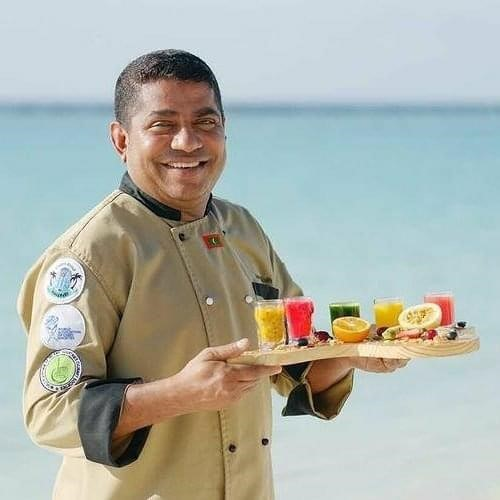
Chef Ishag has over 22 years of experience as a chef, starting his professional career at Full Moon Beach Resort in 1999. He currently works as an Executive Chef at Paradise Island Resort in the Maldives. Chef Ishaq is an active member and culinary judge of the Chef’s Guild of Maldives (CGM) and have served as a member of Hotel Asia Culinary Challenge Judge committee. He has also been a judge of the Food and Hospitality Asia Maldives Culinary Challenge and is a Worlds Association of Chefs Societies approved B License Judge. He holds 4 gold and 3 silver medals along with other numerous awards in the industry.
https://www.villahotels.com/paradise-island/
Ingredients:
- 400 grams local yellow-fin tuna, cut steaks
- 60 grams tomatoes, cut into small diced
- 10 grams basil leaves, toned
- 30 grams Dhon’havaadhu (recipe)
- Salt and pepper to taste
- 6 pieces of banana leaf (8.3 x 11.7 inches)
- 60 grams yellow lemon
- 6 pieces of palm tree leaf stick or toothpicks
Method:
- For the Dhon’havaadhu, slice 45 grams small red onion, slice 30 grams cloves garlic, thinly slice 25 grams galangal, thinly slice 30 grams fresh ginger, slice 15 grams fresh turmeric, 25 grams sliced lemongrass, 3 grams whole curry leaves, 10 grams hot chillies (remove the seeds for a milder heat), 5 grams coriander seeds, 3 grams whole peppercorn and 60ml coconut oil, grind to a fine paste and store in the fridge.
- In a bowl mix tuna, tomato, basil, Dhon’havaadhu, salt, pepper and squeeze the lemon over the mixture.
- Place two tablespoons of the mixture onto a banana leaf and roll until the mixture is completely wrapped. Take a palm tree leaf stick or toothpicks and fasten it to both ends securely.
- Place the wrapped roll in an oiled (medium heat) chargrilled bar and grill each side for 2 minutes. Remove and let it rest.
- Before serving, grill the roll in high heat for approximately three minutes until the banana leaf darkens in colour and grill marks appear.
